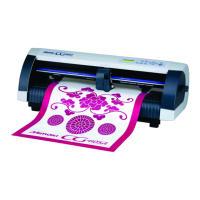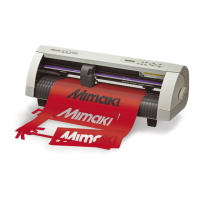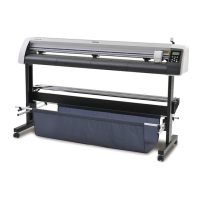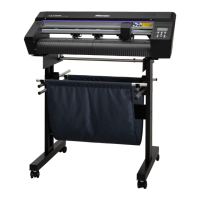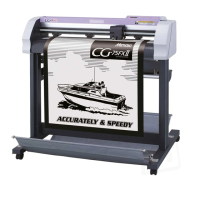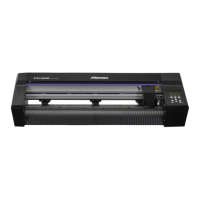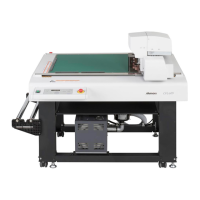Do you have a question about the MIMAKI CG-60st and is the answer not in the manual?
Read manual, limited application, and proper work attire.
Safety guidelines for operating the device, including rollers, moving parts, and modifications.
Understanding the meaning and importance of safety labels for risk awareness.
Explanation of cautionary and hint symbols used in the manual.
Description of the device's interface elements, including the display and operational keys.
Verification of all included accessories for correct quantity and appearance.
Explanation of the parts and their functions located on the front of the plotter.
Detailed explanation of the information displayed on the operation panel.
Explanation of each key's function and how to operate them, including jog keys.
Covers unboxing, attaching legs, roll stay, and connecting cables/power.
Details settings for RS-232C communication between computer and device.
Details settings for 8-bit parallel communication between computer and device.
Describes the initial state before sheet detection.
Describes mode for setup and data reception.
Describes mode for actual cutting/plotting.
Instructions for inserting and securing a cutter into the tool holder.
Instructions for setting up a ball-point pen using the pen adapter.
Defines the operational cutting boundaries based on settings.
Explains their function in holding media and positioning.
Discusses pinch roller movement, safety, and usage with narrow sheets.
Explains SPEED, PRESS, and OFFSET settings for cutters and pens.
Provides recommended settings for pens based on type and media.
For verifying cutting condition settings by cutting squares.
For diagnosing data cutting issues by cutting characters.
Steps to start cutting or plotting after setup completion.
How to pause and resume cutting or plotting operations.
Adjusting settings for cutting quality and sharpness.
Adjusting the rotation of characters or patterns.
Dividing cuts to manage data exceeding sheet width.
Enabling cutting up to the edge of the media.
Operations controlled by the jog keys (arrow keys).
Functions accessed via specific keys on the operation panel.
Terminating current data and starting new operations.
Choosing cutting quality (QUALITY, NORMAL, HIGHspd).
Enabling plotting beyond normal media limits.
Specifying origin and axis direction for cutting.
Defining the effective cutting region on the media.
Aligning the sheet axis with the machine axis for accurate cutting.
Causes and remedies for sheet detection failures.
Causes and remedies for broken lines during cutting.
Issues related to data transfer and communication setup.
Troubleshooting when the device does not respond to host commands.
Causes and remedies for sheet slippage during operation.
When the device drags the tool during operation.
Differences between data length and actual plot length.
How to set the correct blade depth for optimal cutting.
Procedure for replacing a worn or damaged cutter blade.
Detailed technical specifications of the CG-60ST plotter.
Information on available optional blades and tools for different media.
Read manual, limited application, and proper work attire.
Safety guidelines for operating the device, including rollers, moving parts, and modifications.
Understanding the meaning and importance of safety labels for risk awareness.
Explanation of cautionary and hint symbols used in the manual.
Description of the device's interface elements, including the display and operational keys.
Verification of all included accessories for correct quantity and appearance.
Explanation of the parts and their functions located on the front of the plotter.
Detailed explanation of the information displayed on the operation panel.
Explanation of each key's function and how to operate them, including jog keys.
Covers unboxing, attaching legs, roll stay, and connecting cables/power.
Details settings for RS-232C communication between computer and device.
Details settings for 8-bit parallel communication between computer and device.
Describes the initial state before sheet detection.
Describes mode for setup and data reception.
Describes mode for actual cutting/plotting.
Instructions for inserting and securing a cutter into the tool holder.
Instructions for setting up a ball-point pen using the pen adapter.
Defines the operational cutting boundaries based on settings.
Explains their function in holding media and positioning.
Discusses pinch roller movement, safety, and usage with narrow sheets.
Explains SPEED, PRESS, and OFFSET settings for cutters and pens.
Provides recommended settings for pens based on type and media.
For verifying cutting condition settings by cutting squares.
For diagnosing data cutting issues by cutting characters.
Steps to start cutting or plotting after setup completion.
How to pause and resume cutting or plotting operations.
Adjusting settings for cutting quality and sharpness.
Adjusting the rotation of characters or patterns.
Dividing cuts to manage data exceeding sheet width.
Enabling cutting up to the edge of the media.
Operations controlled by the jog keys (arrow keys).
Functions accessed via specific keys on the operation panel.
Terminating current data and starting new operations.
Choosing cutting quality (QUALITY, NORMAL, HIGHspd).
Enabling plotting beyond normal media limits.
Specifying origin and axis direction for cutting.
Defining the effective cutting region on the media.
Aligning the sheet axis with the machine axis for accurate cutting.
Causes and remedies for sheet detection failures.
Causes and remedies for broken lines during cutting.
Issues related to data transfer and communication setup.
Troubleshooting when the device does not respond to host commands.
Causes and remedies for sheet slippage during operation.
When the device drags the tool during operation.
Differences between data length and actual plot length.
How to set the correct blade depth for optimal cutting.
Procedure for replacing a worn or damaged cutter blade.
Detailed technical specifications of the CG-60ST plotter.
Information on available optional blades and tools for different media.
| Type | Cutting plotter |
|---|---|
| Maximum Cutting Speed | 600 mm/s |
| Repeatability | ±0.1 mm |
| Cutting Force | 500 g |
| Media Thickness | 0.1 mm |
| Interface | USB 2.0 |
| Power Supply | AC 100-240 V |
| Operating Temperature | 5-35 °C (41 - 95 °F) |
| Operating Humidity | 35 to 80 % |
